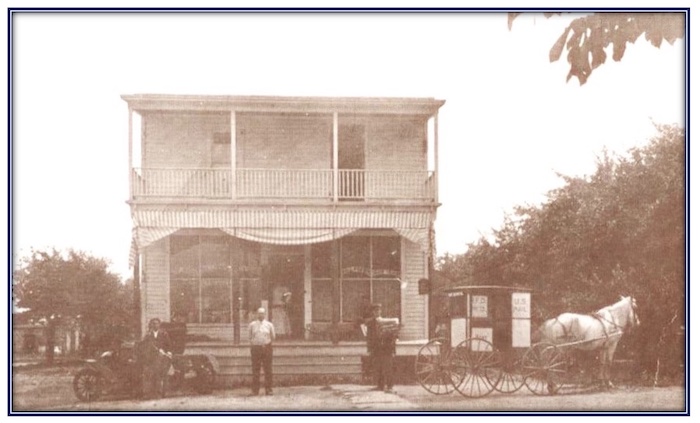57 Post Offices have been in Orleans County’s history, but only 10 today

By Catherine Cooper, Orleans County Historian
“Illuminating Orleans” – Vol. 4, No. 2
CARLTON – This 1912 photograph shows the Kent Post Office in the Town of Carlton. It was located on Kent Road, just north of the N.Y.C. & H. R. line railway station.
In the center stands John Sherwood, who served as Postmaster from 1906 to 1915. The mail carrier on the left, with his 1911 2-cylinder Maxwell automobile is J.C. Hamilton, while on the right with his horse and wagon is George (Burt) O’Dell.
“How many Post Offices currently operate in Orleans County?”
In response to an informal survey, most people replied “5” to this question.
The correct answer would be 10: Albion, Clarendon, Fancher, Holley, Kendall, Kent, Lyndonville, Medina, Morton and Waterport.
The first Post Office established in Orleans County was in Gaines, on July 9, 1816, William J. Babbitt, postmaster.
At one time or another, Post Offices were established in: Albion, Ashwood, Barre, Canal, Carlton (Two Bridges), Carlton Station, Carlyon, Childs (1897-1902), Clarendon, County Line (1894-1903), Eagle Harbor, East Barre (1852-56), East Carlton, East Gaines, East Kendall, East Shelby, Fancher, Farmers (1824-28), Farmingham, Gaines, Hindsburg, Holley, Honest Hill (1897-1903), Hulberton, Jeddo, Kendall, Kendall Mills, Kent, Kenyonville, Knowlesville, Kuckville, Lakeside Park, Lyndonville, Manning (1897-1901), Medina, Millers, Millville, Morton, Murray, North Murray, North Ridgeway, Northton, Oak Orchard, Point Breeze, Riches Corners, Ridgeway, Sawyer, Shelby, Shelby Basin, South Barre, Waterport, West Barre, West Carlton, West Gaines, West Kendall, West Shelby and Yates.* (Total: 57)
As indicated by the dates included some of these Post Offices were short lived, while the names of a few were changed: Northton (1825-30) to Yates and West Carlton (1837-1865) to Kuckville.
“Honest Hill” is a name now forgotten. It was in the Town of Clarendon, with John B. Merrill as postmaster.
The Post Office played a pivotal role in the early history of this Republic. It connected the residents of the colonies and facilitated the spread of ideas through the speedy and affordable delivery of newspapers.
As the westward expansion progressed, so did the Post Office. When people had settled in any number, they soon petitioned for a local Post Office, as a means of establishing their identity – hence the proliferation of Post Offices as seen above. The church, the school and the combined general store/ Post Office were the first building blocks.
Then U.S. Postmaster John Wanamaker said that whether great or small, the Post Office was “the visible form of the Federal Government to every community and to every citizen.”
Rural postmasters were political appointees and so could change with every new election. For many years, the location of the Post Office in Eagle Harbor was either north or south of the bridge, depending on which party was in power.
Postmasters took an oath to uphold the Constitution and to perform their duties diligently. It was not a well-paid position and they had to provide furnishings and supplies. Country postmasters were paid by commission based on the volume of mail handled but the recognition, prestige and foot-traffic to their establishments compensated. In 1856, Albion Postmaster Jonathan O. Wilsea was the highest earning Postmaster in the county ($1,250), while Ralph H. Jackson of West Barre earned the least ($13.13).
The personable T.O. Castle was postmaster of Millville from 1853-57 and again from 1878-1897.
Though the postmaster was usually the local general store operator or business owner, Dr. Frank Lemuel June, a practicing physician and druggist was the Waterport postmaster for ten years until his death in 1911.
Female postmistresses were rare. Rarer still were postmaster/postmistress couples. Ann Batt was appointed postmistress in Fancher in 1978. Her husband Wilfred was postmaster in neighboring Waterport for twelve years. He retired in 1980.
Fred Stelianou was postmaster at Lyndonville for 39 ½ years. He retired in 1992.
The Postal Reform Act of 1970 ended the practice of political patronage in the appointment of postmasters. Subsequently, postmasters were hired from within and were experienced in the operation of an increasingly complex postal service.











































































